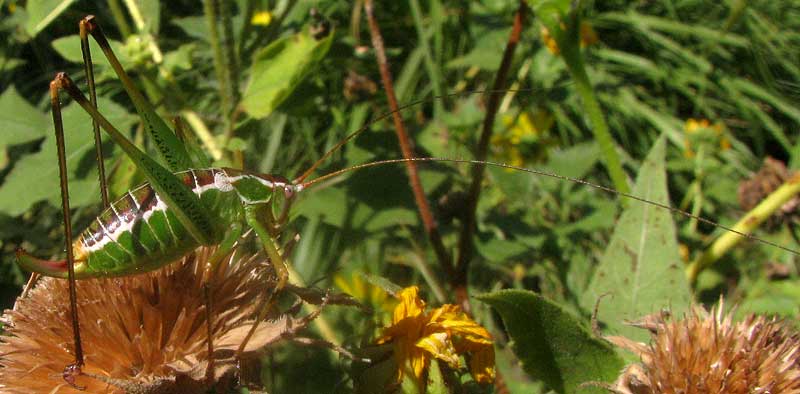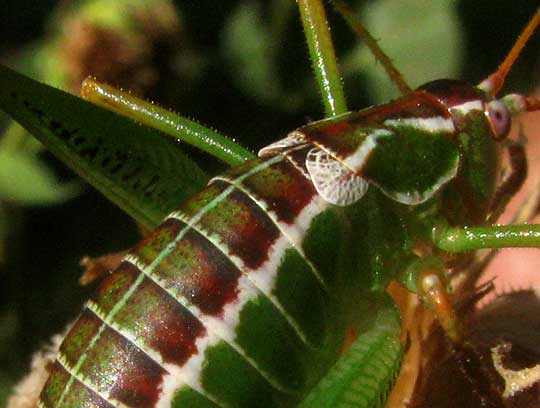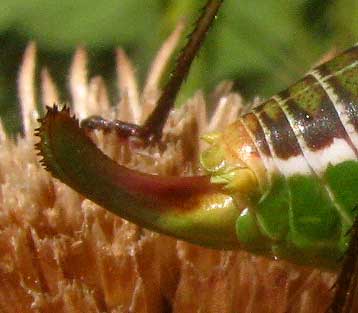Excerpts from Jim Conrad's
Naturalist Newsletter

from the July 20, 2014 Newsletter issued from the Frio Canyon Nature Education Center in the valley of the Dry Frio River in northern Uvalde County, southwestern Texas, on the southern border of the Edwards Plateau; elevation ~1750m (~5750 ft); N29.62°, W99.86°; USA
SHORT-WINGED KATYDID
Atop a wild sunflower's mature fruiting-head a particularly handsome green-cricket sort of critter with a curved back and outlandishly long antennae was wandering about, as seen above.
From it's oversized rear jumping legs and grasshopper-like head with chewing mouthparts I could see that the insect was a member of the Order Orthoptera. However, several times in this Newsletter we've seen that boundaries between the grasshoppers, crickets and katydids who populate the Orthoptera can be obscure. This individual was one who needed at least a little analysis to figure out which group it belonged to. All the grasshoppers I know fold their straight wings neatly over their backs, giving their bodies straight-backed profiles, and since our sunflower visitor's back is not at all straight, and its antennae are too long as well, I figured it wasn't a grasshopper. Crickets normally have flatish bodies, not broadly humped ones like ours, so on that basis I decided we had a katydid. But there's a whole universe of katydids and katydid-like relatives.
Focusing on the wings, our individual turned out to have nothing but tiny, white, lacy, scale-like things emerging from behind the pronotum, which is the big, saddle-shaped scale immediately behind the head, as shown below:

 Such tiny wings could never serve for flying. We've seen wings like this on immature insects, but this individual appeared to be a mature female with a well formed, swordlike ovipositor (egg-layer) at her rear end, shown at the right.
Such tiny wings could never serve for flying. We've seen wings like this on immature insects, but this individual appeared to be a mature female with a well formed, swordlike ovipositor (egg-layer) at her rear end, shown at the right.
Volunteer identifier Bea in Ontario decided that we had one of several species of short-winged katydid, genus Dichopetala, and that explained what was going on. For, in that genus the males possess short forewings enabling them to fly, but females are flightless because they only have those lacy scales seen in our picture. Short-winged katydids of the genus Dichopetala occur only in the Americas, where 22 species are known, with eight listed for North America. So, which one is ours?
OrthSoc.Org provides a wonderful page entitled "Checklist of Katydids North of Mexico," at https://orthsoc.org/sina/katylist.htm.
On that page when you search for the genus Dichopoetala you see the names of the eight species known for North America, and what's so great about this page is that each name is linked to another page providing pictures of pinned specimens of that name, drawings showing features critical for identification, and a distribution map. Someday maybe all plants and animals will be honored with such pages, but so far few are.
On that page you can see that Dichopetala castanea's subgenital plate is broadly rounded along the side, very different from the plates of other listed species. On our picture of the ovipositor, the side of one subgenital plate can be seen below and at the very base of the ovipositor. The plate is green, and its side is broadly rounded just as in the drawing. Also, the drawing of Dichopetala castanea's ovipositor matches ours perfectly, while the ovipositors of other species are narrower and not curved exactly like ours.
Our Chestnut Short-winged Katydid appears to be narrowly endemic just to southwestern Texas and arid northeastern Mexico. Moreover, all short-winged katydids -- all species of the genus Dichopetala -- occur only in Mexico north of the south-central state of Guerrero, north into the US from north-central Texas to central southern Arizona. If you want to see in the wild a female short-winged katydid with her lacy little wing-buds, you just have to come to this part of the world.
Little is known about the species. Now we can inform the world that in mid July mature females wander about sunflower fruiting heads next to ponds in Cooks Slough Nature Park on Uvalde's south side, Uvalde, Texas.